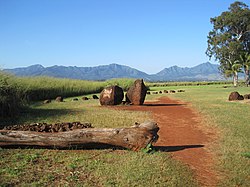United States historic place
| Kūkaniloko Birth Site | |
| U.S. National Register of Historic Places | |
 View from park entrance toward Kolekole Pass View from park entrance toward Kolekole Pass | |
 | |
| Nearest city | Wahiawa, Hawaii |
|---|---|
| Coordinates | 21°30′17″N 158°2′11″W / 21.50472°N 158.03639°W / 21.50472; -158.03639 |
| Area | 5 acres (2.0 hectares) |
| Built | prior to the 13th century |
| Architectural style | Ancient Hawaiian |
| NRHP reference No. | 73000674 and 94001640 |
| Added to NRHP | April 11, 1973 (original) and February 09, 1995 (increase) |
Kūkaniloko Birth Site, also known as the Kūkaniloko Birthstones State Monument, is one of the most important ancient cultural sites on the island of Oʻahu. In 1973, it was first listed on the National Register of Historic Places and its boundaries were increased in 1995, after 5 acres (2.0 ha) of land which included the site became a state park in 1992. The site was the location for some of Hawaiʻi's royal births, and may have served an astronomical function.
Geography
Kūkaniloko lies in the Wahiawā Plateau between Oʻahu's two mountain ranges: the Waiʻanae to leeward, and the Koʻolau to windward. It also lies at the intersection of two major paths of foot travel: the Waialua Trail between the North Shore and ʻEwa Beach, and the Kolekole Trail through the Waiʻanae Range.
The site is not only the place from which the history and power of the island was birthed, known as a piko, but its placement across from the Waiʻanae Range may have been used as a calendar. The sun has used by observing its position at Kūkaniloko using certain markers.
The present day location is near the intersection of Kamehameha Highway and Whitmore Avenue, just north of Wahiawā, Hawaiʻi.
History
Kūkaniloko, meaning "to anchor the cry from within," is the geographic piko of Oʻahu. Kūkaniloko was symbolically the most powerful birth site for the island's high chiefs, among whom Kakuhihewa and Maʻilikūkahi were perhaps most famous. At this site, women gave birth to aliʻi children, surrounded by ali'i witnesses. At the Kūkaniloko birthstone, children born were required to learn the traditions and leaderships of their ancestors in the sites and surroundings.
The Hoʻolonopahu Heiau associated with the site was later destroyed, as were many others in the area, to make room for sugarcane and pineapple fields in the rich soils where sweet potato and yam once grew in abundance. Chiefly families lived along the slopes of the Waiʻanae overlooking the plateau and along the shores of Waialua to the north, and many key battles between rivals for control of Oʻahu were also fought on the central plains surrounding Kūkaniloko.
In 1925, a group called the Daughters of Hawaii recognized and protected the Kūkaniloko Birthstones site. In 1960, Kūkaniloko was passed to Hawaiian Civic Club of Wahiawā.
In August 2023, the site was threatened by a nearby wildfire.
Births at the site
From as early as 1100 until the mid-1600s, fathers and 35 other chiefs would witness the birth of a chief at Kūkaniloko, which was announced by the playing of sacred drums. These 36 witnesses are symbolized by 36 stones in the complex. The newborn chief would then be taken to a nearby temple for purification, severing of the umbilical cord, and a reading of the newborn's genealogy.
Astronomical use
The wide view of the skies from Kūkaniloko might also have made it akin to a Hawaiian Stonehenge. In April 2000, a team from the University of Hawaiʻi Institute for Astronomy recorded designs and shapes on the stones that could have been used to track the movements of celestial objects for calendrical purposes.
Gallery
-
View from entrance stones to central stones
-
Kī plants on raised earth platform
-
Shape of northern Waiʻanae Range
-
Central stones and coconut palms
-
Plant offerings at central stones
-
Corrugated central stone

References
- ^ "National Register Information System". National Register of Historic Places. National Park Service. April 15, 2008.
- ^ "Hawaii State Parks: Oahu: Kukaniloko Birthstones State Historic Site". official web site. Hawai'i Department of Land and Natural Resources. Retrieved February 5, 2010.
- ^ Tarleton, Catherine (February 16, 2017). "Kukaniloko Birthstones: Where Hawaiian royalty was born". Hawaii Magazine.
- Simek, Kelly; Pili, Kamaka (April 30, 2018). "Aloha Authentic: Moku O Wahiawa". KHON News. Retrieved May 27, 2018.
- "Kukaniloko Birthstones". Atlas Obscura. Retrieved November 28, 2021.
- Staff, H. N. N. (August 17, 2023). "Firefighters battle large brush fire in Wahiawa". Hawaii News Now. Retrieved August 17, 2023.
- "Peter Apo: Preserving Kukaniloko, Most Sacred Of Hawaiian Places". Honolulu Civil Beat. September 22, 2016. Retrieved February 28, 2022.
- "Kukaniloko - a Hawaiian Stonehenge?". Retrieved December 28, 2009.
- "Kukaniloko Visit 4/12/00". University of Hawaii Institute for Astronomy. Retrieved December 28, 2009.
External links
- HCCW (Hawaiian Civic Club of Wahiawā Nonprofit) Kukaniloko Website: https://kukaniloko.weebly.com
- Barron, Kamira. Kukaniloko: A Living Legend
- Archived Official website
| U.S. National Register of Historic Places | |
|---|---|
| Topics | |
| Lists by state |
|
| Lists by insular areas | |
| Lists by associated state | |
| Other areas | |
| Related | |
- Heiau
- State parks of Hawaii
- Protected areas of Oahu
- History of Oahu
- Archaeological sites on the National Register of Historic Places in Hawaii
- Archaeological sites in Hawaii
- Buildings and structures in Honolulu County, Hawaii
- Protected areas established in 1973
- 1973 establishments in Hawaii
- National Register of Historic Places in Honolulu County, Hawaii